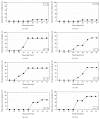Role of nutritional factors at the early life stages in the pathogenesis and clinical course of type 1 diabetes
- PMID: 25883958
- PMCID: PMC4391527
- DOI: 10.1155/2015/382165
Role of nutritional factors at the early life stages in the pathogenesis and clinical course of type 1 diabetes
Abstract
Nutrition has been suggested as an important environmental factor other than viruses and chemicals in the pathogenesis of type 1 diabetes (T1D). Whereas various maternal dietary nutritional elements have been suggested and examined in T1D of both humans and experimental animals, the results largely remain controversial. In a series of studies using T1D model nonobese diabetic (NOD) mice, maternal dietary n-6/n-3 essential fatty acid ratio during pregnancy and lactation period, that is, early life stages of the offspring, has been shown to affect pathogenesis of insulitis and strongly prevent overt T1D of the offspring, which is consistent with its preventive effects on other allergic diseases.
Figures




Similar articles
-
Maternal dietary n-6/n-3 fatty acid ratio affects type 1 diabetes development in the offspring of non-obese diabetic mice.Congenit Anom (Kyoto). 2010 Dec;50(4):212-20. doi: 10.1111/j.1741-4520.2010.00296.x. Congenit Anom (Kyoto). 2010. PMID: 20846138
-
Maternal obesity exacerbates insulitis and type 1 diabetes in non-obese diabetic mice.Reproduction. 2014 Jul;148(1):73-9. doi: 10.1530/REP-13-0614. Epub 2014 Apr 1. Reproduction. 2014. PMID: 24692565 Free PMC article.
-
Maternal environment affects endogenous virus induction in the offspring of type 1 diabetes model non-obese diabetic mice.Congenit Anom (Kyoto). 2005 Sep;45(3):80-4. doi: 10.1111/j.1741-4520.2005.00071.x. Congenit Anom (Kyoto). 2005. PMID: 16131364
-
Animal models of spontaneous autoimmune disease: type 1 diabetes in the nonobese diabetic mouse.Methods Mol Biol. 2007;380:285-311. doi: 10.1007/978-1-59745-395-0_17. Methods Mol Biol. 2007. PMID: 17876100 Review.
-
Type of fatty acids in maternal diets during pregnancy and/or lactation and metabolic consequences of the offspring.J Nutr Biochem. 2015 Feb;26(2):99-111. doi: 10.1016/j.jnutbio.2014.10.001. Epub 2014 Oct 12. J Nutr Biochem. 2015. PMID: 25459884 Review.
Cited by
-
The MHC Class II Antigen-Processing and Presentation Pathway Is Dysregulated in Type 1 Diabetes.J Immunol. 2023 Dec 1;211(11):1630-1642. doi: 10.4049/jimmunol.2300213. J Immunol. 2023. PMID: 37811896 Free PMC article.
-
The role of islet autoantigen-specific T cells in the onset and treatment of type 1 diabetes mellitus.Front Immunol. 2024 Sep 24;15:1462384. doi: 10.3389/fimmu.2024.1462384. eCollection 2024. Front Immunol. 2024. PMID: 39380988 Free PMC article. Review.
-
Association of Maternal Dietary Components During Pregnancy and/or Lactation with Insulin-Dependent Diabetes Mellitus.Int J Endocrinol Metab. 2020 Jul 22;18(3):e93076. doi: 10.5812/ijem.93076. eCollection 2020 Jul. Int J Endocrinol Metab. 2020. PMID: 33257902 Free PMC article. Review.
-
Dietary fat overload reprograms brown fat mitochondria.Front Physiol. 2015 Sep 29;6:272. doi: 10.3389/fphys.2015.00272. eCollection 2015. Front Physiol. 2015. PMID: 26483700 Free PMC article.
-
Early Nutrition and Risk of Type 1 Diabetes: The Role of Gut Microbiota.Front Nutr. 2020 Dec 23;7:612377. doi: 10.3389/fnut.2020.612377. eCollection 2020. Front Nutr. 2020. PMID: 33425976 Free PMC article. Review.
References
-
- Atkinson M. A., MacLaren N. K. The pathogenesis of insulin-dependent diabetes mellitus. The New England Journal of Medicine. 1994;331:1428–1436. - PubMed
Publication types
MeSH terms
Substances
LinkOut - more resources
Full Text Sources
Other Literature Sources
Medical

